How to make stove heating in a private house with air or water circuits
There are many ways to heat a private home, involving the use of gas and electricity. But despite the abundance of modern methods, stove heating is still relevant in the arrangement of country houses and cottages.
Agree, nothing emphasizes the coloring of the Russian hut as much as a wood-burning stove. In addition, solid fuel heating is considered one of the economical options.
The organization of the heating system begins with the selection of furnace equipment and the determination of the type of heating circuit. We offer to understand the device and the principles of functioning of water and air heating based on the furnace. For a better understanding of the issue, we supplemented the material with diagrams and visual photographs.
The content of the article:
Air heating
The reason for the sustainable preference that private house owners give to the stove heating option is economic operation - the availability of firewood, fuel briquettes or coal.
The disadvantage is the limited processing space, which can be eliminated by installing a water and air system based on a brick unit.
The specifics of the device for heating low-rise buildings with an oven are presented in the photo selection:
Principle of operation air heating on the basis of a stove or fireplace it consists in transferring a warm stream heated to operating temperature in a heat exchanger or in a boiler. Air enters either directly into the room or through air ducts.
Due to the relatively short path, he does not have time to lose temperature. The result is a uniform distribution of heat throughout the house.
A chamber for heating the air is arranged above the firebox, so that the hot upper surface of the firebox and the chimney transfer maximum heat to it. Air circulation occurs naturally or through fans.
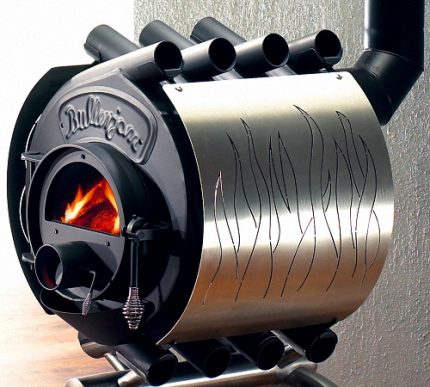
Natural circulation occurs as a result of the density difference between cold and hot air. Cold air entering the heating chamber displaces the hot air in the ducts.
This method does not require the presence of electricity, however, if the air does not move quickly through the heating chamber, it becomes very hot, which can cause problems.
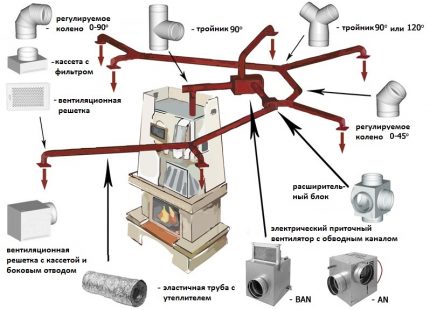
Forced circulation occurs with the use of fans or pumps. However, space heating occurs more quickly and evenly. With forced ventilation, adjusting its mode, you can easily control the amount of air supplied to various rooms, thereby determining the microclimate of individual rooms of the house.
By the type of cold air supply, the systems are divided into two varieties:
- With full recirculation. Heated air masses alternate with chilled air within the same room. The minus of the scheme is that the air quality decreases during each heating / cooling cycle.
- With partial reclamation. Part of the fresh air is taken from the street, which is mixed with part of the air from the room. After heating, a mixture of two air portions is delivered to the consumer. Advantage in stable air quality, lack of volatility.
It is clear that the first group includes channel systems with the natural movement of an air coolant. The second class includes variants with forced movement of air, for the movement of which it is not necessary to arrange a network of ducts.
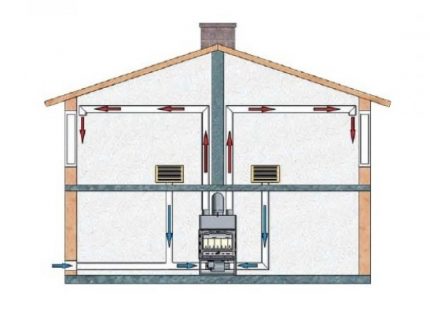
The main advantages of air heating compared to water:
- high efficiency;
- trouble-free;
- lack of radiators in the rooms.
The device circuit with forced movement allows you to do without the construction of a duct system. In addition, this variety can be combined with conditioning, moisturizing and ionizing the air.
If the installation of a device that stimulates the movement of heated air is not planned, then the following methods are used to increase the productivity of the stove:
Increasing the efficiency will spontaneously increase the speed of the air flow: the faster the air heats up, the more intensively the cooled and heated air mass changes.
The main disadvantages of air heating compared to water:
- when using a furnace, the temperature of the supplied air has a significant range, in contrast to the use of other heating means;
- air ducts have a large diameter, so installation must be carried out at the construction stage;
- the location of the furnace in the basement is desirable, otherwise it is necessary to use fans that make noise.
The movement of air in the room has a negative side - it raises dust, however, the use of filters at the outlet of the duct allows you to effectively capture this dust, thus reducing the total amount of dust in the house.
Another feature of air heating with its positive and negative sides is the heat transfer rate. On the one hand, the rooms heat up faster than when heating with a water circuit, on the other hand there is no thermal inertia - as soon as the stove or fireplace goes out, the room immediately starts to cool.
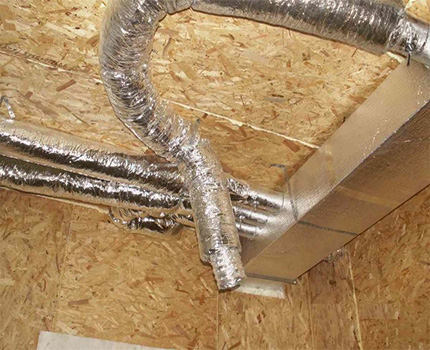
Unlike water heating, installation of an air heating system is not difficult. All elements (pipes, bends, ventilation grilles) can be connected quite simply without welding. There are flexible ducts that can take any shape, depending on the geometry of the premises.
Despite this, air heating systems based on stoves or fireplaces are not yet widespread. More often in an individual low-rise construction, a water circuit is used to heat the premises.
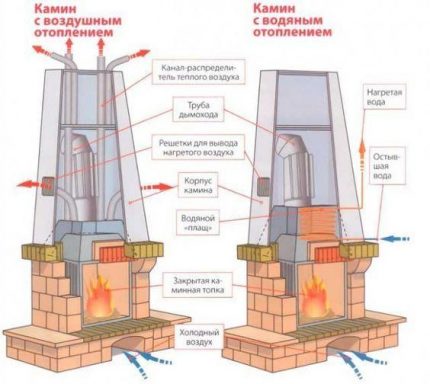
Furnace-based water heating device
The principles of work of any water heating based on the distribution of heat from a local source throughout the room, using the movement of water along the heating circuit.
The main elements of water heating
The main elements for a furnace heating circuit with a water circuit are:
- stove or fireplace with heat exchangerin which water is heated;
- heating circuitwhere heat is transferred to the room;
- expansion tank to prevent damage to the system as a result of increased pressure;
- circulation pump to ensure the movement of water along the circuit.
There are general rules for the functioning of water heating, such as wiring diagramswhich are well known and which must be followed. However, when using the furnace as a heat source, there are specific requirements related to the peculiarity of the temperature regime.
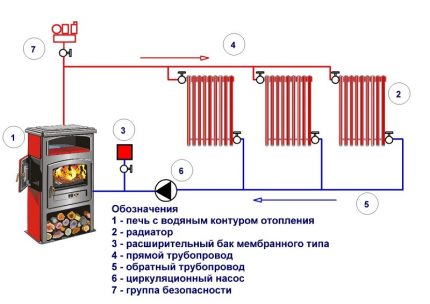
The stoves do not quickly heat up and slowly cool down, uneven heat is generated and only the correct installation of all system components will avoid problems with high-quality heating of the house.
Types of heat exchanger and placement methods
For the manufacture of a heat exchanger for furnaces, sheet “black” steel or heat-resistant stainless steel is used. The use of cast iron as a material for production is difficult, but you can use finished cast iron products, such as cast iron radiators.
It is possible to use copper, which has better thermal conductivity compared to steel, but the price of such a device will be high. The heat exchanger is recommended to be made of steel with a thickness of 3 mm or more. At high furnace temperatures, arising in the case of coal or, especially, coke, it is necessary to use steel with a thickness of 5 mm.
Heat exchangers can be conditionally divided into three types:
- registers, coils and radiatorsconsisting of a set of pipes;
- shirts (boilers)welded from sheet steel;
- combined option in the form of vertical walls connected by pipes (the so-called “books”).
Sheet steel shirts are easier to manufacture and easier to clean from fuel combustion products, however tubular structures have a large heating area. When making a shirt, one must take into account the excess water pressure that occurs when using a membrane expansion tank or lifting water to a high height.
The heat exchanger for water heating based on the furnace can be arranged from improvised materials:
In this case, it is required to use steel with a thickness of at least 5 mm and additionally strengthen the walls with stiffeners to avoid their deformation.
The shapes of tubular structures can be different, however, it is necessary to comply with the condition that the internal size of the pipes is at least 3 cm in diameter. Otherwise, if the circulation speed is slow or the temperature is too high, water will boil.
Registers are made, as a rule, from profile, and not from round pipes, in order to facilitate welding work.
You can make the heat exchanger of the required size yourself. In this case, increased attention should be paid to the quality of welding. If a heat exchanger leaks, all the water will pour into the oven.
In addition, to solve the problem, a large amount of work will have to be done: disassemble the furnace, remove, brew and put the heat exchanger back in, and then reassemble the furnace.
There are two options for the location of the heat exchanger. In the first case, it is placed directly in the firebox, significantly narrowing its space. In the second case, the registers are installed in the hood of non-rotating furnaces, however, the furnace itself in this case has a more complex design.
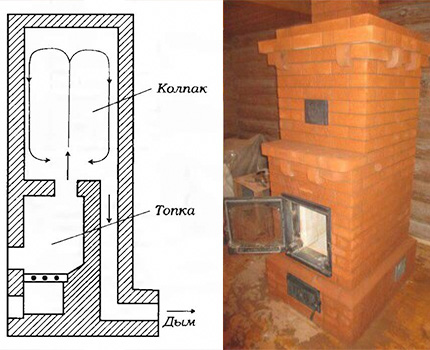
When installing a tubular type heat exchanger, it is necessary to leave a gap between it and the wall of the stove. This is necessary for better heating of the coolant, as well as the ability to clean the register. It is necessary to clean both shirts and registers periodically, since in the event of severe clogging with ash, the heat transfer efficiency decreases.
If there is a hob, cleaning occurs after it is removed. If the furnace has only a heating function, then cleaning takes place through the furnace door.
Water circulation in the heating circuit
The basic principles of organizing the natural circulation of water in the system are to simulate an “acceleration collector” at the outlet of the heat exchanger and to create a constant slope of the pipes of the heating circuit of 3-5 °.
The general meaning of the “acceleration collector” is that heated water rises vertically from the furnace, and then is distributed along the heating circuit.
The circulation occurs due to the difference in the specific gravity of cold and hot water. Cold water is heavier than hot, and flowing down to the heat exchanger, displaces hot water up the pipe. The entry point of the “return” must be lower than the water outlet from the radiators, otherwise the water circulation will be very slow or it will not be at all.
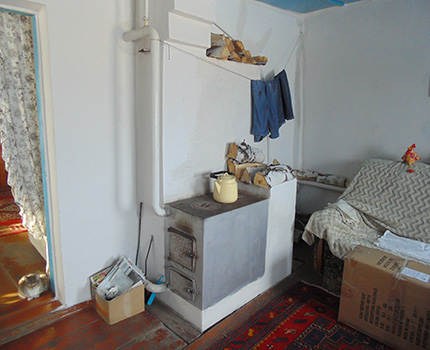
To increase the speed of movement of water along the heating circuit install a circulation pump. Thus, a more rapid and even distribution of heat throughout the house occurs. Several pumps can be used at the same time for different heating circuits.
In the presence of power surges, it is necessary to apply Voltage regulatorsince failure of the pump can lead to serious consequences for the entire system.
Pumps can conditionally be divided into two groups relative to the position of the engine: with a “dry” rotor and a “wet” rotor. By type of voltage: models operating from a 220 V network and pumps operating from 12 V power sources
The motor in pumps with a “dry” rotor is isolated from the impeller immersed in water by O-rings. Compared to pumps with a submerged motor, “dry” pumps have a higher efficiency.
However, among the shortcomings can be called a high noise level, the need for regular maintenance and less motor resources. Therefore, in a private house, as a rule, circulating pumps with a “wet” rotor are used.
The choice of the type of pump power depends on the possibility of natural circulation of water in the system. If it is impossible without the participation of the pump, then the choice should be made in favor of the option with the support of 12 V voltage and uninterruptible power supply.
Otherwise, in the event of a power outage, water may boil and the system will fail. If natural circulation is possible, then it is better to purchase a more common and cheaper option with 220 V.
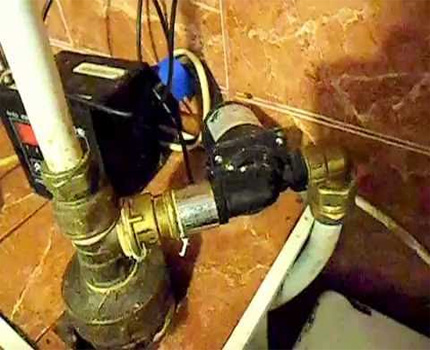
When installing a pump with a power supply of 220 V, it is necessary to organize the possibility of the functioning of the heating system during a power outage. To do this, a shut-off valve is installed on the pipe, and bypassing it, a bypass pipe with a pump is installed (the so-called “bypass”).
A filter tap is installed on the bypass pipe in front of the pump, and then a shut-off valve is installed. By adjusting the position of the stopcocks on the main and bypass pipes, you can turn on the forced and natural circulation mode.
As a rule, the pump is installed on the “return” near the furnace, so that the temperature of the liquid that will pass through the device is the lowest. This will significantly extend the life of the pump.
In addition, it is necessary to place the maximum possible number of heating system controls in one place, so that in case of emergencies, you can quickly take measures to eliminate them.
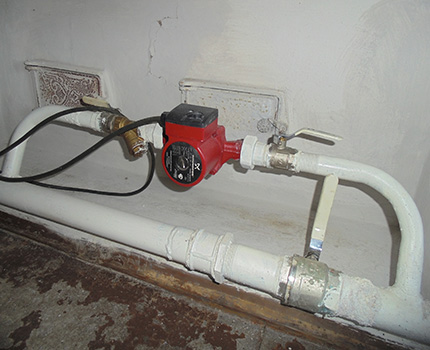
Rules for using the expansion tank
The liquid expands when heated, and if this happens in a closed system, then the pressure inside it will increase significantly, and the increase in pressure is fraught with a breakthrough of water. The use of a safety valve is impractical, since after cooling the water and reducing its volume, air will be launched into the system.
Therefore, in heating circuits with forced movement of water, special expansion tankswhich are open or closed types. Their volume is calculated based not only on the maximum thermal expansion of the liquid (5-7%), but also taking into account the possibility of boiling the system.
An open-type tank equips the water circuit of the gravity-type furnace heating, that is, with the natural transportation of the coolant. It is a metal tank of arbitrary shape located at the very top of the heating circuit. It communicates directly with the atmosphere, due to which the coolant partially evaporates.
The pipeline is connected to the bottom or the bottom quarter of the tank, and a pipe is welded to the top of it to drain water in case of overflow and the release of air from the system. Practice shows that the volume of an open tank should be at least 15% of the volume of water in the heating system.
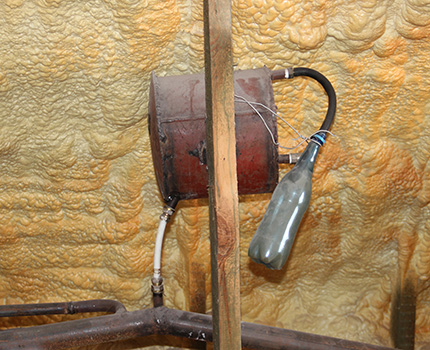
A closed or membrane type tank is a closed vessel with a membrane inside. Water, heating, increases the pressure, stretches the membrane and enters the tank. In case of excess pressure, the automatics are activated, and the excess coolant is discharged into the sewer.
After the first discharge, usually there is no longer any reason for its re-production, since the volume of the coolant becomes equal to the volume of the system.
The closed diaphragm tank is mounted in front of the pump. Such a capacity, unlike an open type tank, cannot get rid of air itself, therefore, at the top of the heating circuit, it is necessary to install a Mayevsky crane (mechanical air vent) or its automatic analogue.
The only element of the membrane tank that can fail over time is the membrane, so it’s better to buy a tank with the possibility of replacing it.
When buying a closed tank, which is sometimes called a hydraulic accumulator, the main thing is not to confuse it with a hydraulic accumulator for water supply.
For a membrane tank used in heating, the operating temperature is up to 120 ° C, and the pressure is up to 3 Bar. For water supply, tanks with a temperature of up to 70 ° C and a pressure of up to 10 Bar are used.
The choice between pipes and radiators
As a water circuit for stove heating, you can use a system of plastic pipes with radiators (batteries) or a system of metal pipes. The main advantage of using radiators is that they look prettier in comparison with massive air ducts.
Plastic wiring can be easily hidden on the floor, as it does not give off heat. Although, according to the rules, the wiring of water heating should be open. However, polymer pipelines have limitations: they cannot be laid where there is a likelihood of melting and direct UV exposure.
The advantage of metal pipes is the lower price of the entire heating circuit, ease of installation and less frequent problems when operating the system.
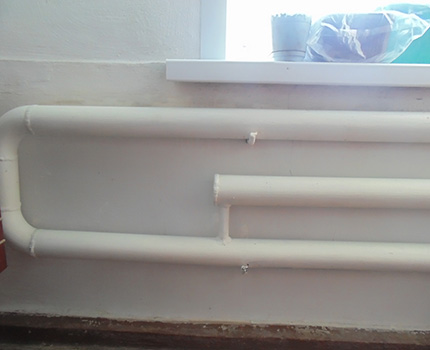
Significant advantage radiator systems is the ease of temperature adjustment. Even the most accurate calculations of the temperature of the room can be adjusted. For example, a small child under 6 months old is recommended a temperature of 19-21 ° C, while a comfortable temperature in the rest of the house is considered 25 ° C.
To ensure such a temperature for a long period of time in a room, it is necessary to completely or partially close the heat supply tap to one of the radiators. In the case of a metal pipe, the problem can also be solved, but in a more complicated way: to reduce the heat transfer of the pipe segment using polyurethane or foil shells.
Another heating circuit option could be water heated floor. This is a very comfortable type of heat supply to the human sensation, however, installing a warm floor is much more time-consuming than the options previously considered.
In addition, when using a warm floor, it is not possible to provide a slope for the natural circulation of water, which, combined with a small diameter of the warm floor pipes, leads to a prerequisite for the use of a circulation pump.
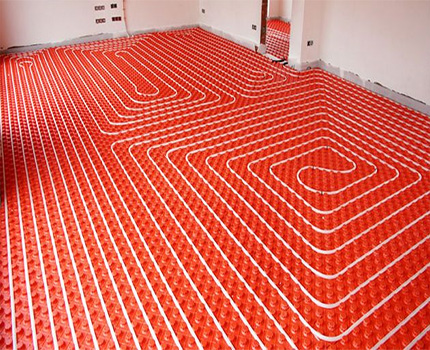
Prevent freezing of the heating system
The use of water as a coolant has one minus - in case of freezing of the heating system, the pipeline and appliances will be damaged. In this case, it is especially difficult to restore the heat exchanger integrated into the furnace.
This problem is relevant for homes that may not be heated for a long time in the winter. One way to prevent damage to the system is to use antifreeze instead of water for heating systems.
For residential premises, propylene glycol-based liquids are used as antifreeze, as a non-toxic substance, unlike ethylene glycol.
However, the idea of using antifreeze has its drawbacks:
- propylene glycol-based antifreeze is expensive (from 80 r / liter);
- the specific heat capacity of antifreeze is less than that of water (approximately 15%), therefore, a large furnace power and a large surface area of space heating devices are required;
- antifreeze has a higher dynamic viscosity than water, therefore a more powerful circulation pump is necessary, and natural circulation is impossible;
- when heated, antifreeze expands to 40%, so it is necessary to use a large expansion tank of a closed type;
- propylene glycol is very fluid, therefore it penetrates through compounds in the heating system through which water does not penetrate;
- propylene glycol is incompatible with galvanized pipes, because when contacted, antifreeze additives lose their properties;
- when boiling antifreeze (which is likely when using furnaces), an irreversible chemical reaction occurs, as a result of which the whole system will have to be drained and refilled antifreeze.
For antifreeze, the heating system must be calculated in advance - its use in projects implemented for water is quite problematic.
Moreover, a project using antifreeze will be much more expensive than a water heating system. Therefore, its use has not yet become widespread in private homes with stove heating, and other methods are used to prevent freezing.
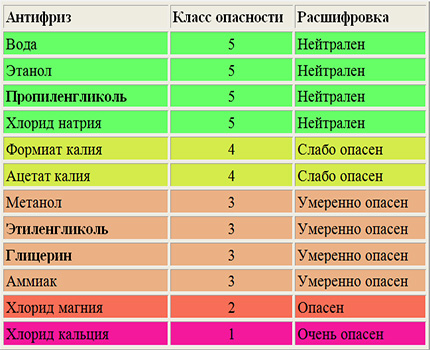
Draining water from the circuit and the shirt or register of the furnace is the most common solution to the problem with a prolonged absence of the owners of the house.In addition to additional work, the disadvantages of this method include the access of air to the metal elements of the system from the inside and, as a result, the spread of corrosion.
Also, as a solution to the problem for a short period of time, integration with a small capacity electric boiler into the heating circuit is used. His work at a minimum level of energy consumption is able to temporarily maintain a positive water temperature.

Conclusions and useful video on the topic
A working heating system based on a stove and a water circuit in a private house with an area of 80 square meters:
The heat is supplied to the heating system from stoves and fireplaces in batches, which complicates the task of calculating the parameters of the elements of the heating circuit. Conducting alterations to the circuit is quite problematic, therefore, with a lack of experience in this area, it is better to turn to specialists with the skills to solve such problems.
Do you have experience in organizing stove heating? Or are you warming your house like that and would like to share your impressions of the operation of the stove? Please leave comments and ask questions. The feedback form is located below.

 How to make heating on waste oil with your own hands: schemes and principles of arrangement
How to make heating on waste oil with your own hands: schemes and principles of arrangement 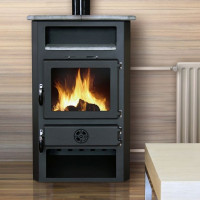 A furnace with a water circuit for heating a house: features of furnace heating + selection of the best option
A furnace with a water circuit for heating a house: features of furnace heating + selection of the best option 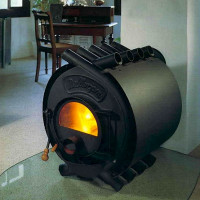 How to make a Buleryan oven with your own hands: step-by-step instructions on how to make
How to make a Buleryan oven with your own hands: step-by-step instructions on how to make 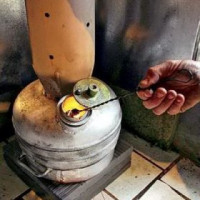 How to make a potbelly stove on waste oil with your own hands: a review of the best homemade products
How to make a potbelly stove on waste oil with your own hands: a review of the best homemade products 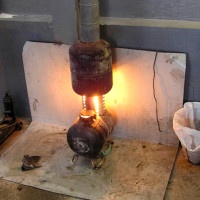 The furnace for working out of the pipe: how to make an effective furnace for used oil from improvised materials
The furnace for working out of the pipe: how to make an effective furnace for used oil from improvised materials 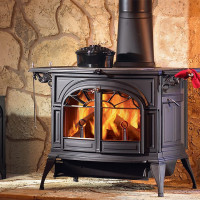 Wood stoves for heating a private house: rating of popular models + benchmarks for the buyer
Wood stoves for heating a private house: rating of popular models + benchmarks for the buyer  How much does it cost to connect gas to a private house: the price of organizing gas supply
How much does it cost to connect gas to a private house: the price of organizing gas supply  The best washing machines with dryer: model rating and customer tips
The best washing machines with dryer: model rating and customer tips  What is the color temperature of light and the nuances of choosing the temperature of the lamps to suit your needs
What is the color temperature of light and the nuances of choosing the temperature of the lamps to suit your needs  Replacement of a geyser in an apartment: replacement paperwork + basic norms and requirements
Replacement of a geyser in an apartment: replacement paperwork + basic norms and requirements
Now in my house there is an ordinary red brick stove. Steam type heating system. I am not satisfied with this type, but I bought a house with such a system, while in this regard I have not changed anything. It takes a very long time to heat, so that all the pipes are heated, while they cool down in an hour, if the briquette does not smolder in the stove, maintaining the temperature of the boiler. Sometimes the pipes begin to boil, a very unpleasant sound. In addition, I often add water to the pipes. We have to go to all sorts of tricks. I’m thinking of changing the system to air.
We used to have a large Russian stove. Occupied the floor of the kitchen. Dismantled, put another. The boiler remained the same. It’s a pity, of course, that the grate is ordinary. It was possible to put the tubes, combine everything into one and it turned out just fine. We have a small house. Recently insulated from the outside, now the savings are visible on the face. Plans to put a pump that would drive fluid through the system. Well, I consider pouring antifreeze into pipes as complete nonsense. Only water and nothing more.
As far as I can remember, there were always no batteries at home, namely pipes. Neat and beautiful. I don’t want to change anything, it’s always warm at home.
The question is different. They added a new half to the house - is it possible to feed in different directions? I am afraid that if you attach to the old system, already to the return, it will be cold in the new half. Both the old and the new part of the house are 60 sq.m.
Please, those who understand, tell me how to save the old system!?
Hello. Marina, you would at least sketch out the heating circuit and describe what kind of boiler you have. We would tell you how best to make heating in your outbuilding with a minimum of losses. Theoretically, this is possible with valves to regulate the flow.
We decided to break the old gas burner stove.And build a new one too with a burner. But I don’t know whether it is necessary to make a metal casing for the stove, because old in the casing. Previously, gas workers did not allow connection if the furnace was without a metal strapping.